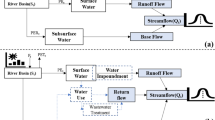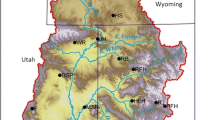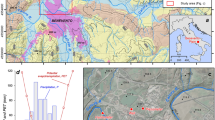Abstract
Groundwater/surface-water interactions can play an important role in management of water quality and quantity, but the temporal and spatial variability of these interactions makes them difficult to incorporate into conceptual models. There are simple methods for identifying the presence of groundwater/surface-water interactions; however, identifying flow mechanisms and pathways can be challenging. More complex methods are available to better identify these mechanisms and pathways but are often too time consuming or costly. In this work, a simple method for interpreting and identifying flow mechanisms and sources using temporal variations of river response functions is presented. This approach is demonstrated using observations from two sites along the Arkansas River in Kansas, USA. A change in flow mechanisms between the rising and falling limbs of river hydrographs was identified, along with a second surface-water source to the aquifer, a finding that was validated with stable isotope analyses.
Résumé
Les relations nappe–rivière peuvent jouer un rôle important dans la gestion de la quantité et de la qualité de l’eau, mais la variabilité spatiale et temporelle de ces interactions rend difficile leur prise en compte dans les modèles conceptuels. Il y a des méthodes simples pour identifier l’existence de relations nappe-rivière. Cependant, l’identification des mécanismes et voies d’écoulement peuvent constituer un défi. Des méthodes plus complexes sont disponibles pour mieux identifier ces mécanismes et voies de transfert, mais elles sont souvent trop chronophages et coûteuses. Dans ce travail, une méthode simple est présentée pour interpréter et identifier les mécanismes de transfert et leurs origines, en utilisant les variations temporelles des fonctions de réponse d’une rivière. Cette approche est démontrée en utilisant les observations effectuées pour deux sites sur le cours de la rivière Arkansas, au Kansas (Etats-Unis d’Amérique). Un changement des mécanismes d’écoulement entre les montées et descentes des hydrographes de la rivière a été identifié conjointement avec une deuxième origine d’eau de surface alimentant l’aquifère, un résultat qui a été validé par les analyses d’isotopes stables.
Resumen
Las interacciones agua subterránea–agua superficial pueden desempeñar un papel importante en el manejo de la calidad y cantidad del agua, pero la variabilidad temporal y espacial de estas interacciones hace que sea difícil incorporarlas en los modelos conceptuales. Existen métodos sencillos para identificar la presencia de las interacciones agua subterránea/agua superficial; Sin embargo, la identificación de los mecanismos y trayectorias de flujo puede ser un desafío. Existen métodos más complejos para identificar mejor estos mecanismos y trayectorias, pero a menudo insumen demasiado tiempo o son costosos. En este trabajo, se presenta un método sencillo para interpretar e identificar los mecanismos de flujo y los aportes utilizando las variaciones temporales de las funciones de las respuestas fluviales. Este enfoque se demuestra usando observaciones de dos sitios a lo largo del río Arkansas en Kansas, EEUU. Se identificó un cambio en los mecanismos de flujo entre las ramas ascendentes y descendentes de los hidrogramas del río, junto con un segundo aporte de agua superficial hacia el acuífero, hallazgo que fue validado con análisis de isótopos estables.
摘要
地下水/地表水相互作用在水的数量和质量管理中可以发挥重要的作用,这些相互作用的时空变化使其很难包含在概念模型中。有确定地下水/地表水相互作用是否存在的简单方法;然而,确定水流机理和水流通道具有挑战性。有更复杂的方法能够更好地确定这些机理和通道,但通常太费时或者代价太高。在本研究中,提出了采用河流响应功能的时间变化解译和确定河流机理和来源的一个简单方法。利用美国堪萨斯州阿肯色河两个地点的观测数据展示了该方法。确定了河流水位图上升和下降翼之间河流机理的变化,以及确定了第二个到含水层的地表水源,这个发现得到了稳定同位素分析的验证。
Resumo
Interações entre águas subterrâneas e superficiais podem desempenhar uma função importante na gestão da qualidade e da quantidade da água, mas a variabilidade temporal e espacial dessas interações as torna difíceis de incorporar à modelos conceituais. Existem métodos simples para identificar a presença de interações entre águas subterrâneas e superficiais; entretanto a identificação de fluxos e caminhos preferenciais pode ser desafiador. Métodos mais complexos estão disponíveis para uma melhor identificar esses mecanismos e caminhos preferenciais mas são geralmente dispendiosos em tempo ou custo. Nesse trabalho, apresenta-se um método simples para interpretar e identificar mecanismos de fluxo e fontes usando variações temporais de funções de resposta fluviais. Essa abordagem é demonstrada usando observações de dois locais ao longo do Rio Arkansas, Kansas, EUA. Uma mudança nos mecanismos de fluxo entre os membros ascendentes e descendentes dos hidrogramas do rio foi identificada, junto com uma segunda fonte de águas superficiais ao aquífero, uma discoberta que foi validada com análises de isótopos estáveis.










Similar content being viewed by others
References
Amsler ML, Blettler MC, de Drago IE (2009) Influence of hydraulic conditions over dunes on the distribution of the benthic macroinvertebrates in a large sand bed river. Water Resour Res 45(6):W06426
Baird KJ, Stromberg JC, Maddock T III (2005) Linking riparian dynamics and groundwater: an ecohydrologic approach to modeling groundwater and riparian vegetation. Environ Manag 36(4):551–564. doi:10.1007/s00267-004-0181-z
Barnes CJ, Allison GB (1988) Tracing of water movement in the unsaturated zone using stable isotopes of hydrogen and oxygen. J Hydrol 100(1-3):143–176
Battin TJ, Kaplan LA, Findlay S, Hopkinson CS, Marti E, Packman AI, Newbold D, Sabater F (2008) Biophysical controls on organic carbon fluxes in fluvial networks. Nat Geosci 1(2):95–100
Blasch KW, Bryson JR (2007) Distinguishing sources of ground water recharge by using δ2H and δ18O. Ground Water 45(3):294–308. doi:10.1111/j.1745-6584.2006.00289.x
Bohling GC, Jin W, Butler JJ Jr (2011) Kansas Geological Survey Barometric Response Function software user’s guide. http://www.kgs.ku.edu/HighPlains/OHP/index_program/brf.html. Accessed January 3, 2017
Briggs MA, Lautz LK, MacKenzie JM (2012) A comparison of fibre-optic distributed temperature sensing to traditional methods of evaluating groundwater flow to streams. Hydrol Process 26(9):1277–1290
Brunke M, Gonser T (1997) The ecological significance of exchange processes between rivers and groundwater. Freshw Biol 37(1):1–33
Butler JJ Jr, Jin W, Mohammed GA, Reboulet EC (2011) New insights from well responses to fluctuations in barometric pressure. Ground Water 49(4):525–533
Cardenas MB (2009) Stream–aquifer interactions and hyporheic exchange in gaining and losing sinuous streams. Water Resour Res 45(6):W06429
Cheng L, Liu W, Li Z, Chen J (2014) Study of soil water movement and groundwater recharge for the Loess Tableland using environmental tracers. Trans ASABE 57(1):23–30
Conant B Jr (2004) Delineating and quantifying groundwater discharge zones using streambed temperatures. Ground Water 42(2):243–257
Coplen TB, Herczeg AL, Barnes C (2000) Isotope engineering: using stable isotopes of the water molecule to solve practical problems. In: Cook P, Herczeg AL (eds) Environmental tracers in subsurface hydrology. Kluwer, Dordrecht, The Netherlands, pp 79–110
ESRI (Environmental Systems Research Institute) (2017) World imagery. https://www.arcgis.com/home/item.html?id=10df2279f9684e4a9f6a7f08febac2a9. Accessed January 17, 2017
Fanelli RM, Lautz LK (2008) Patterns of water, heat and solute flux through streambeds around small dams. Ground Water 46(5):671–687
Glennon RJ, Maddock T III (1994) In search of subflow: Arizona’s futile effort to separate groundwater from surface water. Ariz L Rev 36:567
Hancock PJ, Boulton AJ (2005) Aquifers and hyporheic zones: towards an ecological understanding of groundwater. Hydrogeol J 13(1):98–111
Harrington GA, Cook PG, Herczeg AL (2002) Spatial and temporal variability of ground water recharge in central Australia: a tracer approach. Ground Water 40(5):518–527
Hayashi M, Rosenberry DO (2002) Effects of groundwater exchange on the hydrology and ecology of surface waters. Groundwater 40(3):309–316
Heilweil VM, Sweetkind DS, Gerner SJ (2013) Innovative environmental tracer techniques for evaluating sources of spring discharge from a carbonate aquifer bisected by a river. Groundwater 52(1):71–83
Kalbus E, Reinstorf F, Schirmer M (2006) Measuring methods for groundwater/surface-water interactions: a review. Hydrol Earth Syst Sci 10(6):873–887
KGS (Kansas Geological Survey) (2016) Water well completion records (WWC5) database. Kansas Geological Survey, Lawrence, KS. http://kgs.ku.edu/Magellan/WaterWell/index.html. Accessed November 28, 2016
Klaus J, McDonnell JJ (2013) Hydrograph separation using stable isotopes: review and evaluation. J Hydrol 505:47–64
Latta B (1950) Geology and ground-water resources of Barton and Stafford counties, Kansas. KGS Bull 88, Kansas Geological Survey, Lawrence, KS, 228 pp
Loheide SP II, Lundquist JD (2009) Snowmelt-induced diel fluxes through the hyporheic zone. Water Resour Res 45(7):W07404
Lyon SW, Desilets SLE, Troch PA (2009) A tale of two isotopes: differences in hydrograph separation for a runoff event when using δD versus δ18O. Hydrol Process 23(14):2095–2101
McCarthy KA, McFarland WD, Wilkinson JM, White LD (1992) The dynamic relationship between groundwater and the Columbia River: using deuterium and oxygen-18 as tracers. J Hydrol 135(1-4):1–12
Poulsen JR, Sebok E, Duque C, Tetzlaff D, Engesgaard PK (2015) Detecting groundwater discharge dynamics from point-to-catchment scale in a lowland stream: combining hydraulic and tracer methods. Hydrol Earth Syst Sci 19:1871–1886
Rasmussen TC, Crawford LA (1997) Identifying and removing barometric pressure effects in confined and unconfined aquifers. Ground Water 35(3):502–511
Rosenberry DO (2002) Effects of ground water exchange of the hydrology and ecology of surface water. Ground Water 40(3):309–316
Schornberg C, Schmidt C, Kalbus E, Fleckenstein JH (2010) Simulating the effects of geologic heterogeneity and transient boundary conditions on streambed temperatures: implications for temperature-based water flux calculations. Adv Water Resour 33(11):1309–1319
Selker J, van de Giesen N, Westhoff M, Luxemburg W (2006) Fiber optics opens window on stream dynamics. Geophys Res Lett 33(24):L24401
Sophocleous M, Townsend MA, Vogler LD, McClain TJ, Marks ET, Coble GR (1987) Stream–aquifer interaction along the Arkansas River in central Kansas: field testing and analysis. KGS Open File Rep 87-2, Kansas Geological Survey, Lawrence, KS
Sophocleous M, Perkins SP, Pourtakdoust S (1993) Stream–aquifer numerical modeling of the Kinsley to Great Bend reach of the Arkansas River in central Kansas: final report. KGS Open File Rep 93-32, Kansas Geological Survey, Lawrence, KS
Spane FA (2002) Considering barometric pressure in groundwater flow investigations. Water Resour Res 38(6):1–18
Spane FA, Mackley RD (2011) Removal of river-stage fluctuations from well response using multiple regression. Ground Water 49(6):794–807
Stadnyk T, Gibson J, Longstaffe FJ (2014) Basin-scale assessment of operation base flow separation methods. J Hydrol Eng 20(5). doi:10.1061/(ASCE)HE.1943-5584.0001089
USGS (United States Geological Survey) (2016a) National Water Information System. https://waterdata.usgs.gov/nwis/. Accessed November 30, 2016
USGS (United States Geological Survey) – National Geospatial Program (2016b) USGS TNM Topo Base Map. https://viewer.nationalmap.gov/viewer/. Accessed November 30, 2016
Westbrook CJ, Cooper DJ, Baker BW (2006) Beaver dams and overbank floods influence groundwater/surface-water interactions of a Rocky Mountain riparian area. Water Resour Res 42(6). doi:10.1029/2005WR004560
Whittemore DO, Butler Jr. JJ, Healey JM, McKay SE, Aufman MS, Brauchler R (2005) The impact of stream–aquifer interactions on ground-water quality in the alluvial aquifer of the Middle Arkansas River. KGS Open File Rep 2005-5. http://www.kgs.ku.edu/Hydro/Publications/2005/OFR05_5/. Accessed November 30, 2016
Whittemore DO, Sophocleous MA, Butler Jr. JJ, Wilson BB, Tsou M-S, Zhan X, Young DP, McGlashan M (2006) Numerical model of the middle Arkansas River subbasin. KGS Open-File Rep 2006-25, Kansas Geological Survey, Lawrence, KS, 122 pp
Winter T, Harvey JW, Franke OL, Alley WM (1998) Ground water and surface water: a single resource. US Geol Surv Circ 1139, 87 pp
Acknowledgements
This project was funded through a grant from the US Geological Survey—Kansas Water Resources Institute. We gratefully acknowledge technical support and coordination with the US Geological Survey’s Kansas Water Science Center, Hays Field Office, and Wichita Field Office. In particular, we thank Brian Loving, Nathan Sullivan, Lori Marintzer, Slade Rupp-Hackney, and Michael Holt of the USGS. We thank University of Kansas students Brooks Bailey and Trevor Osorno for their assistance in the field. We thank associate editor Jean-Michel Lemieux, reviewer Henning Moe, colleagues Geoff Bohling and Jim Butler, and two anonymous reviewers for their comments and contributions during manuscript development. We also thank Julie Tollefson for her editorial contributions.
Author information
Authors and Affiliations
Corresponding author
Rights and permissions
About this article
Cite this article
Brookfield, A.E., Stotler, R.L. & Reboulet, E.C. Interpreting temporal variations in river response functions: an example from the Arkansas River, Kansas, USA. Hydrogeol J 25, 1271–1282 (2017). https://doi.org/10.1007/s10040-017-1545-9
Received:
Accepted:
Published:
Issue Date:
DOI: https://doi.org/10.1007/s10040-017-1545-9




